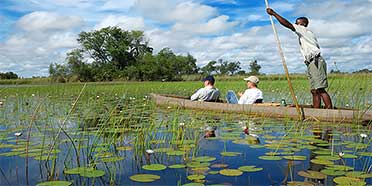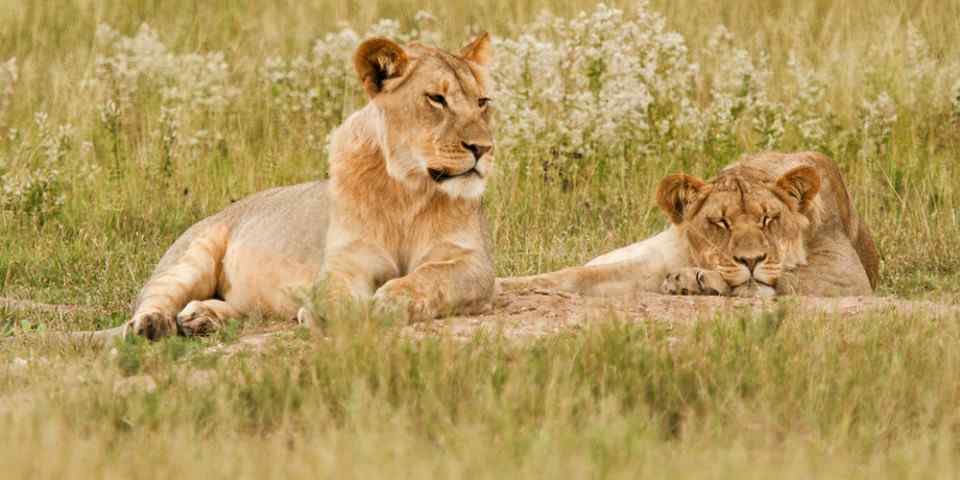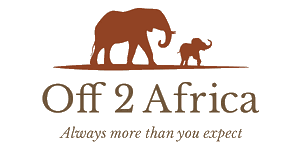
Ariadne is a renowned African wildlife photographer whose work is featured in many well-known guidebooks and magazines.
18 people found this review helpful.
Botswana, home to more big animals than people
Botswana is pretty much one huge desert. With a tiny population of less than 2 million, most of the country is wild and untouched. As opposed to most the other safari countries covered here, I’ve only visited Botswana once. I flew around from park to park and was blown away by the emptiness of this magnificent country. Parks are mostly unfenced, and this is a country where you might get a feeling how Africa was before the population growth and habitat encroachment of the last century.
The highlight of my trip was the magnificent Okavango Delta. This permanent water source is a magnet for animals, which can be spotted most easily on a classic game drive. The best game viewing is in Moremi Game Reserve. Personally, I was less worried about seeing big game than about absorbing the atmosphere of the place. I loved gliding silently through the delta by ‘mokoro’ dugout canoes. The water birds are phenomenal and the feeling of being absorbed into this massive eco-system was unique.
One... Read more of my favourite places in Africa is Tuli Block. As opposed to most of the parks in Botswana, this one is quite accessible coming from South Africa. Mashatu Game Reserve is the biggest private game reserve in Southern Africa and it combines the perks of being in a privately-run park – for instance, excellent guides and off-road driving - with the real sense of wilderness that comes with being part of a vast unfenced eco-system.

Christopher is a British travel writer and has contributed to various Fodor's guidebooks and a range of travel magazines.
15 people found this review helpful.
Botswana: Land of desert and giants
Botswana’s substantial safari appeal is largely founded on the following simple formula: an extreme abundance of dramatic landscapes and wildlife (including all of the Big 5), and a comparative dearth of people. The human population of this peaceful and stable African success story numbers a mere 2.4 million in an area of land roughly the size of France (which has a population of over 67 million).
The elephant population, however, is the largest in Africa, with more than 50,000 to be found in Chobe National Park alone. Driving through the country late last year, we regularly saw elephants crossing the main road, and also had to stop for a buffalo herd at least 500 strong. Seeing another vehicle was a much rarer experience.
Botswana is also a relatively wealthy country and roads and infrastructure are generally good, which means self-drivers can get the sense of remote Africa without having to brave some of the potholes (both literal and metaphorical) that you might find... Read more in neighbouring countries such as Zimbabwe or Zambia.
The wildlife and birdlife meccas of the Okavango Delta and the Chobe River defy their inhospitable surroundings and are certainly among the must-sees, though they can get busy. Lesser-frequented gems include Nxai Pan National Park and Central Kalahari Game Reserve. For the more intrepid, the latter is best experienced on a mobile camping safari.
Botswana is completely hunting-free and a leading light in African eco-tourism – most lodges and camps found across the country also play their part in carrying this torch.

Alan is a travel writer and author of over 20 Lonely Planet guidebooks, including the guides to Southern Africa and Zambia & Malawi.
12 people found this review helpful.
Botswana: A dream country for safari enthusiasts
Botswana tends to fly under the radar in southern Africa in many ways. But it shouldn’t. This politically stable country is one of Africa’s success stories with admirable conservation policies, a growing economy, wildlife to enthrall visitors and an excellent hospitality industry. It’s a land of great contrasts from the dry, searingly hot Kalahari Desert to the wonders of the water-soaked Okavango Delta. The Kalahari and Makgadikgadi Pans offer desert-adapted animals such as the tiny, nimble steenbok, the stately oryx (gemsbok) with their dead-straight horns, giraffe, enormous kudu and impala. But most impressive of all are the black-maned Kalahari lions. At night the roar of these magnificent beasts reverberates around the Kalahari sands. It’s a sound that once heard is unlikely to be forgotten. Primeval, fearsome, raw power sends tingles down the spine.
In the north of the country is the Okavango Delta, truly one of Africa’s great wonders, fed by the Okavango River and dependent... Read more on the rains in the Angolan highlands each year. It’s a series of waterways which supports large vegetated areas and an even greater number of animals. Elephants are here in huge numbers, cats such as lions, leopard and even cheetah can be seen. There are buffalo herds several hundred strong and water-loving antelope such as red lechwe, waterbuck and the rare sitatunga. Other commonly seen animals include giraffe, impala, wildebeest, zebra, hippo and hyena. Rhino are not as common but wild dogs have made a comeback and sightings are quite possible.
Botswana, however, is not cheap – it has positioned itself very much at the top end of luxury tourism. Self-drive is possible, and there are some public parks and reserves with campsites, but you need experience driving on the sandy roads, many of which become impossible during the Wet season when they turn into churning mud, slippery and difficult to negotiate. Although the price tag of a safari in Botswana can be a drawback, the admirable conservation programs set a benchmark for other safari countries. And there’s something pretty special experiencing such a high degree of luxury in the bush. It’s popular with older safari tourists as well as families.
You’ll need a strong stomach for the light aircraft flights which drop you between bush airstrips close to the various lodges. The aviation industry is safe and well run in Botswana but the flights can get bumpy!

Philip is an acclaimed travel writer and author of many guidebooks, including the Bradt guides to Uganda, Tanzania, Kenya and South Africa.
12 people found this review helpful.
The thirsty Kalahari and swampy Okavango
This vast, dry and thinly populated republic – supporting the equivalent of half the population of Madrid in an area larger than Spain – is one of Africa’s few unambiguous economic success stories, thanks largely to the immense mineral wealth that lies beneath its sandy Kalahari soils. Botswana is also an exceptional safari destination, having embarked on a pioneering brand of high-cost, low-impact ecotourism back in the 1990s. Although this policy has made it unpopular with budget travellers, it does ensure that those who make it to Botswana can enjoy a genuine wilderness experience.
The country’s most important attraction is the Okavango Swamp, a vast and lushly vegetated inland delta formed by the Kavango River as it dissipates into the desert sands. The delta doesn’t quite match some other classic African reserves in terms of big game – though it does support decent populations of lion, elephant, buffalo and various antelope – but there’s a rich sense of uninterrupted space... Read more and tranquillity associated with exploring the labyrinthine waterways in a ‘mokoro’ dugout canoe, and the birdlife is tremendous. Good to visit in combination with Okavango is Chobe National Park, which lies in the far north, along the Zambezi, and hosts some of the most impressive elephant numbers in Africa.
An altogether different sense of wide open space is attached to the little-visited Central Kalahari Game Reserve. This is reputedly the largest conservation area in Africa, and it forms the heart of a vast semi-desert ecosystem as wild and untrammelled as anywhere in Africa. For top big game viewing, however, my favourite spot in Botswana is Mashatu Game Reserve, a large private in the Tuli Block, close to the border with South Africa – no better place to see all three big cat species (lion, leopard and cheetah) along with the endangered African wild dog







